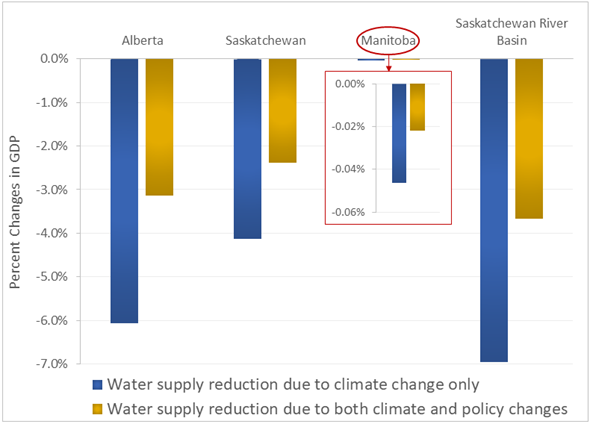PhD student studies how a changing climate and mitigative policies can impact the water economy in the Saskatchewan River Basin.
A changing climate, societal pressures, and increasing water consumption, all challenge water security around the globe and threaten water-dependent economies. While Canada is considered water-rich worldwide, this perceived water abundance is more a myth than a reality. No region in Canada exemplifies future threats to water security more than the semi-arid prairies in Western Canada – home to 80% of Canada’s agriculture.
Laurie Tollefson, a Science manager at Agriculture and Agri-Food Canada with more than 35 years of experience in agriculture, irrigation, and drainage work, explained why.
“In the West of Canada, in the prairie provinces, water is the lifeblood of agriculture. I’ve grown up in this province on a farm in Southern Saskatchewan, and I know that water is a limiting factor for production of food. There’s so much competition for water for agriculture, livestock, mining and large industries in this area,” he said.
Since this region naturally has a variable climate, dry spells are not uncommon in the Prairies. The Prairies became the ‘breadbasket’ of Canada by adjusting farming and water management practices to the increasing aridity of the regions.
“Because of this variability in water supply, people in the three prairie provinces have developed a high coping range for events like droughts and floods compared to other provinces,” says Robert Halliday, former Director of Canada’s National Hydrology Research Centre.
Despite this enhanced coping capacity, the Prairie drought of 2001-2002 was still one of the most expensive natural disasters in Canadian history with an estimated GDP loss of almost CAD $5.8 billion.
“I always wonder what would happen if a drought lasts 10 years, and one of the climate change scenarios we have to think about is how resilient those communities are… water managers in Alberta generally say that three years is about where a manageable drought ends,” added Halliday.
Numerous studies warn of the expanding threat of water supply shortages in the future due a changing climate, as well as increasing demand by various industry sectors. This raises questions about how water use and consumption by various industrial sectors can impact other sectors in multi-jurisdictional river basins.
Leila Eamen, a PhD student working with Drs. Saman Razavi and Water Institute director Roy Brouwer in the Integrated Modelling Program for Canada, is studying that very question. Her research explores the interrelationships between water and the economy to assess impacts of a varying climate and associated policy measures in the Saskatchewan River Basin, stretching from Jasper National Park in the West all the way to Cedar Lake in Manitoba in the East.

Leila Eamen and Dr. Roy Brouwer
“The Saskatchewan River Basin is a multi-jurisdictional river basin and water resources are governed and operated by different authorities in each jurisdiction, regardless of the hydrological sub-basins. All these units are interconnected systems from economic and hydrological points of view”, Eamen explained.
Eamen’s hydro-economic model builds on what’s called a supply-side Input-Output (SIO) analysis that studies the interdependencies of industry sectors in an economy by analyzing the flow of goods and services. In her research, she specifically studies the flow of water through different sectors in sub-basins of the Saskatchewan River Basin and measures its impact on the economy under different climate change and policy scenarios.
For example, if climate change reduces water supply for different sectors, an expected policy response may be to introduce new ways of allocating water between water-using sectors. These allocation policies are likely to be implemented differentially across the various provinces that share the Saskatchewan River Basin based on different priorities in each jurisdiction. As a result, each industry sector may receive a different supply of water even if climate change reduces water availability consistently throughout the basin.
Eamen’s SIO model considers, then, how water use in industries such as crop and animal production, and oil and gas upstream in Alberta, affect water availability for manufacturing industries or utilities downstream in Manitoba and assesses the economic value associated with the resulting water use.
Eamen’s study measured the extent of these changes to assess a dollar value for possible economic losses we are likely to face under different scenarios. Her study is the first to take this approach for the Saskatchewan River Basin as an integrated unit.
“It's very good to show people, politicians, or decision-makers the economic impact of an activity within a particular hydrologic basin… This allows you to maybe target your resources a little more where they might do the most good and where there might be the most impact… Particularly as climate becomes hotter, we're going to have to use our water more efficiently” said Tollefson.
Her results show a minimum reduction of 5% in economic output in utilities in Manitoba and maximum reduction of about 21% in rain-fed crop and animal production in a sub-basin in Alberta in the absence of mitigative policy interventions. These mitigative measures include re-prioritizing demands and considering alternative water sources (such as groundwater and poor-quality water sources) to fulfill part of the water demand for sectors like mining and manufacturing.
The figure below shows resulting overall reduction in the GDP of each province and the entire Saskatchewan River Basin as a whole.

Total
reduction
in
GDP
by
province
for
the
Saskatchewan
River
Basin [See source]
These percent reductions translate to monetary losses of CAD $22.1 billion in Alberta, $3.2 billion in Saskatchewan, and $28 million in Manitoba under climate change scenarios without mitigative policy measures. With mitigative policy measures, however, these losses reduce to CAD $11.5 billion, $1.8 billion and $13 million, respectively.
“This means that mitigative water allocation policies have the potential to reduce GDP losses due to climate-induced water shortage in Saskatchewan River Basin between 40% to 50%,” said Eamen.
But how do we know these model results resemble how reality will unfold under a highly unpredictable climate in the future, among other uncertainties of a changing economy? Attempting to address this question is the next step in Eamen’s research where she will focus on finding out how well these hydro-economic models perform under an uncertain future.
“Human nature is that people tend to remember the recent past and have trouble understanding that what’s happened recently isn’t what might be considered normal [for the future]. For example, there were large floods in the late 1800s in the basin, but 2013 came as a surprise in Calgary because nobody thought it through… And so a challenge for water management policy is to really identify what normal could look like and then have policies that deal with extremes,” highlighted Halliday.
Another way to test model accuracy is to run study design, assumptions and results by water managers and practitioners in the field to get their feedback on whether it all makes sense in the absence of reliable data.
Eamen travelled to Regina in January of 2019 to present the methodology and preliminary results of her research to the Water Council of the Saskatchewan Chamber of Commerce. She has also shared this research with the representatives from the Saskatchewan Ministry of Agriculture, Agriculture and Agri-Food Canada, and SaskPower.
Interdisciplinary studies like Eamen’s that connect projected resource changes to policy response scenarios and resulting economic impacts are highly valuable to both policymakers and the industry. It helps stakeholders and policy-makers make informed decisions inclusive of trade-off considerations between different sectors, as well as prepare better for the consequences of those decisions.
That's why I have so much respect for what Leila is trying to do because she's trying to do something that really hasn't been done. People like me, we talk about best professional judgement. [For example] water managers have a lot of skill and knowledge about how the basin operates to make allocation decisions. I'm sure Alberta has their own input-output economic model for the provinces, but previous models don't consider all water users of varying scales,” said Halliday.
Leila
Eamen
will
continue
working
on
developing
modelling
frameworks
to
identify
robust
water
resources
management
strategies
based
on
the
economic
indicators
and
hopes
to
assist
decision-makers
in
allocating
limited
water
resources
among
competing
users
more
efficiently
under
unknown
future
conditions.
Read more on Leila Eamen's research by following this link or the citation below.
Citation: Leila Eamen, Roy Brouwer and Saman Razavi. 2020. The economic impacts of water supply restrictions due to climate and policy change: A transboundary river basin supply-side input-output analysis. Ecological Economics, (172), 106532. https://doi.org/10.1016/j.ecolecon.2019.106532
Other sources consulted:
Government of Canada | Agriculture and Agri-Food Canada (2016). Synthesis Report: Lessons from the Canadian Drought Years 2001 and 2002. https://www.agr.gc.ca/eng/agriculture-and-climate/drought-watch/managing-agroclimate-risk/lessons-learned-from-the-canadian-drought-years-2001-and-2002/?id=1463593613430
For questions or comments on this news article, contact Laila Balkhi at laila.balkhi@usask.ca